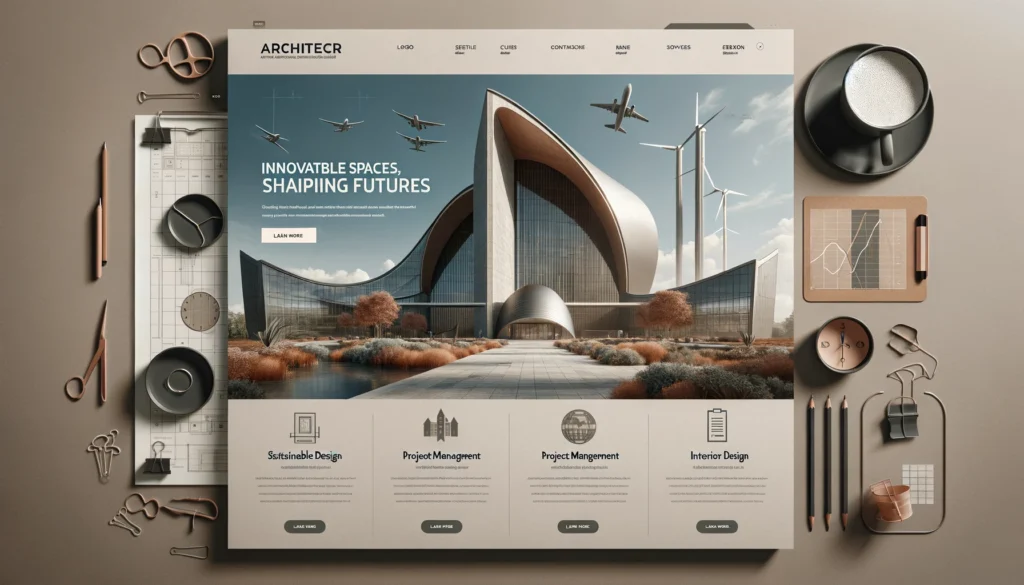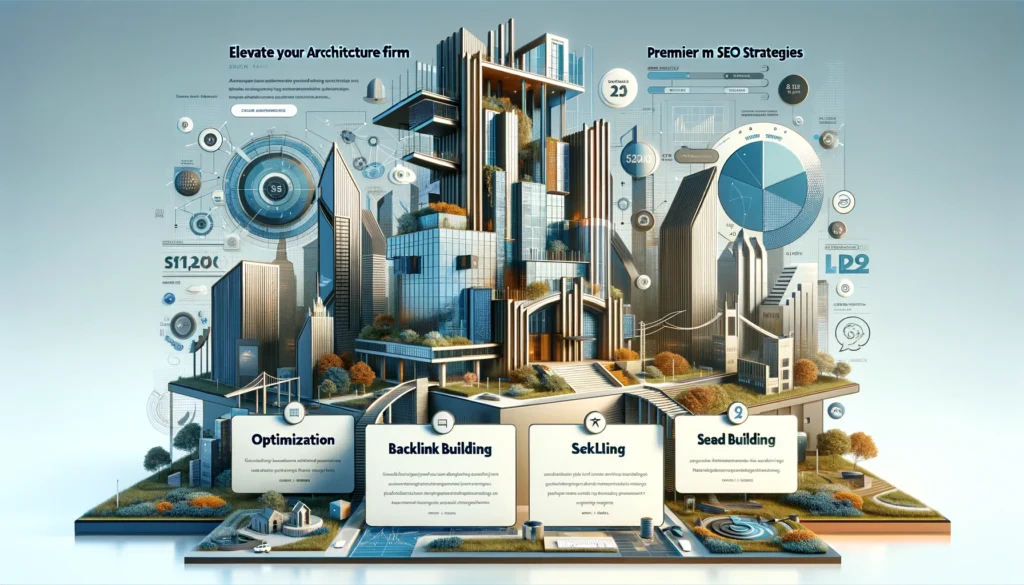What is The Role of SEO For Architect Business?
Today, we are here to explain how the architecture industry and SEO also carry a connection. Mainly this blog post is an eye-opener for the people who are entirely unaware of SEO for architects. Whether you are an architect or a fashion brand, solely having a website is not enough. In this world of digitalization, a website can get created anytime and anywhere, but to help your website grow business, you need a lot more.

There is no denying that the website will help you effortlessly showcase your recent projects, team, and accomplishments for search intent. But, you must understand that it is essential to ensure to optimize your website for search engines. So, what is keeping you waiting? Get all set up to date prepare your website for your architectural firm at the top of the search engine results pages!
But before we do that, unearth more about what SEO is and the basic SEO for architects!
Here are some important point that help Architect business owner if they use SEO on their website, social media posts and other content strategy for marketing.
What is SEO (Search Engine Optimization?)
You must understand the meaning of SEO before you dive right into how SEO will help your architectural website. SEO or search engine optimization is a specialized language for many strategies and methods utilized to help your site’s position in Google’s (and other search engines and web crawlers’) indexed lists.

We are sure that numerous people must be wondering why an architect should care about it at all? According to speculated data, the best three ranks in Google’s list items represent more than 55% of natural snaps, with the central spot alone getting around 30% of the snap-throughs.
Pause for a second and think about it. Approximately 33% of searchers click on the primary outcome they see. Everybody needs to be number one, so we will show you five stages you can take to assist with helping your architectural site’s positioning. Continue reading to uncover the steps that will ensure your top search engines crawl and potential clients notice your website.
What Steps Should Architects take to improve their SEO?
To begin blog post with, we should discuss what your site needs to fulfill the fundamental SEO rules. These specialized components are regular for all areas, regardless of industry or specialty!
1. Work Out On Your Landing Pages

For the ones wondering what a landing page is, let us help you understand. It is an integral part of your website with a unique URL. On the off chance that you have a web page with numerous spots that clients can tap on and explore, you have different presentation pages. So, it would help if you utilized these for your potential benefit. The additional landing pages you have, the more extensive your advanced reach. Each new page sets you to rank higher, yet you need to utilize this device effectively. Showcase your portfolio on your landing pages.
- Clear and Compelling Headlines: Use headlines that immediately communicate the value proposition and grab the visitor’s attention.
- Concise and Persuasive Content: Write concise, persuasive copy that highlights the benefits of your service or product, addressing the visitor’s needs and how you can solve their problems.
- Strong Call-to-Action (CTA): Place clear, compelling CTAs throughout the page, using action-oriented language that encourages visitors to take the next step (e.g., “Schedule a Consultation” or “Download Our Free Guide”).
- Simplify the Design: Use a clean, uncluttered design that focuses on the key message and CTAs, removing any unnecessary distractions that could detract from the conversion goal.
- Use High-Quality Visuals: Incorporate professional images or videos that are relevant to your services, enhancing the appeal of the page and helping to visually communicate your message.
- Optimize for Mobile: Ensure the landing page is responsive and offers a seamless experience on mobile devices, considering the increasing trend of mobile usage.
- Loading Speed: Optimize the page’s loading speed by compressing images, minifying CSS and JavaScript, and leveraging browser caching, as faster loading times can significantly improve user experience and conversions.
- Testimonials and Trust Signals: Include testimonials, reviews, or logos of past clients to build trust and credibility with prospective customers.
- Contact Information: Clearly display contact information or a contact form, making it easy for visitors to reach out with questions or inquiries.
- Live Chat Option: Consider integrating a live chat feature to provide immediate assistance or answer any questions visitors might have.
- A/B Testing: Regularly test different elements of the landing page (e.g., headlines, CTAs, images) to see what works best and continuously optimize based on data.
- Use Urgency and Scarcity: Where appropriate, use elements of urgency (e.g., limited time offer) or scarcity (e.g., limited availability) to encourage quicker decision-making.
- Easy Navigation: Ensure that the navigation is intuitive and helps visitors find the information they need without confusion or frustration.
- Lead Capture Forms: If using forms to capture leads, keep them short and straightforward, asking only for essential information to reduce friction and abandonment.
- Privacy Policy: Include a link to your privacy policy near form submissions to reassure visitors about the security and privacy of their data.
2. Meta Titles and Descriptions
Metadata is the thing that tells web crawlers (and clients) what’s going on with your site or page. By adding relevant metadata, you make it simpler for bugs to comprehend your web pages’ substance better. Slithering the whole web is asset serious and costly. In this way, by aiding the bots (one more name for insects), you make it bound to hang out on your site for somewhat longer and dissect your pages in general. Pay close attention to Meta title tags, meta description tags, and page headings.

- Incorporate Primary Keywords: Identify the primary keyword or phrase that best describes your page’s content or the services you offer and ensure it’s included in the meta title. Place the most important keywords towards the beginning of the title.
- Be Specific and Descriptive: Use descriptive language that accurately reflects the content of the page. For architects, this could involve specifying the type of architecture or services offered (e.g., “Sustainable Residential Architecture” or “Commercial Architectural Design Services”).
- Geographic Targeting: If your services are targeted to a specific geographic location, include the city or region in the meta title to attract local searches (e.g., “Award-Winning Architects in Chicago”).
- Brand Name: Include your firm’s name in the meta title, ideally at the end, to build brand recognition (e.g., “Modern Home Design Solutions | [Firm Name]”).
- Unique Value Proposition: Highlight what sets you apart from the competition. Mention any specializations, awards, or unique selling points (e.g., “Eco-Friendly Architectural Designs | LEED Certified”).
- Keep It Concise: Meta titles should be kept under 60 characters to ensure they display fully in search results without being cut off.
- Avoid Keyword Stuffing: While it’s important to include relevant keywords, ensure the title remains readable and appealing to potential visitors. Overstuffing with keywords can negatively impact perceptions and search rankings.
- Use Numbers or Dates: When applicable, including numbers or dates can make the title more attractive and specific, suggesting updated and detailed content (e.g., “Top 10 Architectural Trends of 2024”).
- Leverage Modifiers: Use modifiers like “Best,” “Top,” “Expert,” “Custom,” to make your titles more appealing and to target long-tail keywords that potential clients might be searching for.
- Action Words: Start with or include an action word to make the title more engaging and compelling (e.g., “Discover Contemporary Architectural Designs”).
3:How to Choose the Right Keywords for Your Architecture Website

Keywords are one of the essential components of SEO. These search terms are what searchers go into the web crawlers and are essentially questions clients present google search for that the web search tools mean to reply. Take note of the following points- perform appropriate keyword research, mix your keywords in the description, use your keywords in a way that appears to be flowy.
- Understand Your Target Audience: Before you begin, have a clear understanding of who your target audience is, what services they are looking for, and what terms they might use to search for these services online.
- Use Keyword Research Tools: Leverage tools like Google Keyword Planner, SEMrush, Ahrefs, or Moz Keyword Explorer to find relevant keywords. These tools can provide insights into search volume, competition, and variations of your primary keywords.
- Analyze Competitors: Look at the websites of competitors or firms that rank highly for your desired keywords. Identify which keywords they are targeting and how they incorporate these into their content. This can provide ideas for keywords you might have overlooked.
- Consider Keyword Intent: Keywords can be categorized based on the searcher’s intent (informational, navigational, transactional, or commercial). Choose keywords that match the intent of your website’s content and the actions you want visitors to take.
- Focus on Long-Tail Keywords: Long-tail keywords are longer, more specific phrases that visitors are likely to use when they’re closer to making a decision or purchase. They often have lower search volume but can lead to higher conversion rates due to their specificity (e.g., “sustainable residential architecture firms in Seattle”).
- Incorporate Local Keywords: If your firm targets clients in specific locations, include geo-specific keywords in your strategy (e.g., “architects in Miami” or “New York modern architecture”).
- Use Architectural Styles and Services: Include keywords related to the specific architectural styles, services, or project types you specialize in (e.g., “commercial architecture design,” “art deco architects,” “green building design”).
- Optimize for Semantic Search: Search engines are increasingly focusing on understanding the intent behind search queries. Include related terms, synonyms, and natural language phrases that potential clients might use to find your services.
- Monitor and Adjust Regularly: Keyword effectiveness can change over time due to trends in the industry or shifts in client interests. Regularly review your keyword strategy and adjust based on performance data and new keyword opportunities.
- Balance Between Volume and Competition: Ideally, target keywords that have a decent search volume but not so much competition that it’s difficult to rank for them. Finding this balance is crucial for new or smaller websites.
- Consider the User Journey: Think about the different stages of the user journey (awareness, consideration, decision) and select keywords that cater to each stage, providing relevant content that guides them through the process.
- Content Integration: Once you’ve chosen your keywords, integrate them naturally into your website’s content, including page titles, meta descriptions, headings, and throughout the body text, in a way that enhances readability and user experience.
4. Include Your Architecture Projects Images And Experience

Yes, that is right. Undeniably, there are numerous architects. Why will someone pick you? You must optimize your project images appropriately and put them in equal proportion with the text. In the end, do not forget to add alt-tags to your photos to let search engines and visually-impaired users know what they contain.
- Interactive Portfolio Gallery: Instead of static images, create an interactive gallery where visitors can click on a project to see a detailed case study. Include before-and-after sliders, 360-degree views, or virtual tours to make the experience immersive.
- Augmented Reality Previews: Offer an augmented reality (AR) feature on your website that allows visitors to visualize your projects in their own space or on a predefined scene. This can be particularly engaging for residential projects.
- Video Testimonials: Blend images of your projects with video testimonials from satisfied clients. This approach adds a personal touch and builds trust with prospective clients by showcasing successful collaborations.
- Time-lapse Project Videos: Include time-lapse videos of your projects from start to finish. This not only demonstrates your project management skills but also visually presents the transformation brought about by your designs.
- Design Philosophy Section: Integrate a section that pairs images of your projects with explanations of your design philosophy. This helps visitors understand the thought process behind your work and how it aligns with their values or needs.
- Interactive Timeline: Create an interactive timeline highlighting milestones in your career or business. Include project completions, awards, and other significant achievements, with clickable elements leading to more detailed information.
- Client Journey Walkthrough: Design a section that walks potential clients through the process of working with you, from initial consultation to project completion, illustrated with images from various projects that highlight each stage.
- Sustainability Highlight: If sustainability is a key aspect of your work, dedicate a section to showcase how your projects incorporate sustainable design principles. Use icons and short descriptions to highlight features like energy efficiency, use of sustainable materials, and landscape integration.
- Geo-tagged Project Map: Incorporate an interactive map that allows visitors to explore your projects by location. This is particularly useful for firms with international projects or those wanting to showcase regional expertise.
- Behind-the-Scenes Content: Share behind-the-scenes content that shows your team in action, from sketching initial concepts to visiting construction sites. This humanizes your brand and demonstrates your hands-on approach to architecture.
5: Obtain backlinks from architecture firms and related websites.

- Create High-Quality Content: Produce compelling, informative, and visually appealing content related to architecture that other websites would naturally want to link to. This can include blog posts, case studies, infographics, and architectural design trends.
- Guest Blogging: Offer to write articles or blog posts for reputable architecture, design, and real estate websites. In your author bio or within the content, include a link back to your website.
- Partner with Industry Influencers: Collaborate with influencers in the architecture and design space on projects, interviews, or features. They can share the collaboration on their platforms with a link back to your site.
- Leverage Social Media: Share your content on social media platforms and architecture-related forums or groups. Engaging with your community can lead to natural backlinks as people share your content.
- Participate in Online Forums and Communities: Join and actively participate in architecture and design forums, such as Archinect or Houzz. Offer valuable insights and advice, and where appropriate, link back to relevant content on your site.
- Submit Your Work to Architecture Directories: Submit your projects to online architecture project directories and platforms that allow architects to showcase their work, ensuring a link back to your website is included.
- Online Awards and Competitions: Enter your projects into online architecture awards or competitions. Winners and participants often receive backlinks from the award website.
- Press Releases: If you have noteworthy company news or launch a significant project, distribute a press release to architecture and business news outlets.
- Create Linkable Assets: Develop resources that serve the architecture community, such as white papers, architectural design templates, or original research. These assets can encourage backlinks from educational institutions and industry blogs.
- Reach Out for Backlinks: Identify websites that mention your architecture firm or projects but don’t currently link to you. Reach out to them with a polite request to add a link to your site.
- Host Webinars or Online Workshops: Offer free or paid webinars on topics related to architecture and design. Promote these through various channels, and collaborate with other industry professionals to increase reach and backlinks.
6: Focus on Local seo

Local SEO is crucial for architect businesses looking to attract clients in their geographical area. Here are strategies to utilize local SEO effectively:
- Google My Business (GMB) Optimization: Claim and optimize your Google My Business listing. Ensure your business name, address, phone number (NAP), and operating hours are accurate. Regularly update your GMB profile with fresh photos, projects, and news.
- Local Keywords: Incorporate local keywords into your website’s content, titles, meta descriptions, and URLs. For example, use “architect in [City Name]” or “architecture services in [Region]” to target local searches.
- On-Page SEO for Local Search: Create location-specific pages on your website if you serve multiple areas. These pages should include local keyword optimization, area-specific projects, and testimonials from local clients.
- Local Link Building: Obtain backlinks from local businesses, industry partners, and local chamber of commerce websites. Sponsor or participate in local events and charities to increase your local presence and link opportunities.
- Local Business Citations: Ensure your business is listed in local online directories and architecture-specific directories. Consistency in your NAP information across these listings is vital for local SEO.
- Collect Reviews: Encourage satisfied clients to leave positive reviews on your Google My Business listing and other review platforms. Respond to reviews, addressing any concerns and thanking clients for their feedback.
- Use of Schema Markup: Implement local business schema markup on your website. This helps search engines understand your business’s location and services, enhancing your visibility in local search results.
- Social Media Engagement: Use social media platforms to engage with the local community. Share local events, projects, and news. Use geo-tags in your posts to increase visibility in local search results.
- Mobile Optimization: Ensure your website is mobile-friendly. A significant portion of local searches are performed on mobile devices, so a responsive design is crucial for ranking well in local search results.
- Content Marketing: Create content that appeals to your local audience, such as case studies of local projects, guides on local building regulations, or insights into architectural trends in your area.
- Local PR: Get featured in local newspapers, magazines, and news websites. Local media coverage can boost your local SEO through high-quality backlinks and increase brand awareness in your community.
- Track Your Performance: Use tools like Google Analytics and Google Search Console to track how well your local SEO efforts are performing. Monitor metrics such as local search rankings, website traffic from local searches, and conversions from local visitors.
FAQ
Q: What is SEO and Why is it important for Architects?
A: SEO stands for Search Engine Optimization. It’s the process of improving your website’s ranking in the search engine rankings and results for keywords the most relevant keywords to your business. This makes it more likely for potential clients to find your website when they’re looking for architects.
Q: What are the benefits of SEO for Architects?
A:
Increased website and traffic generated More leads and projects Improved brand awareness Boosted credibility Cost-effective marketing Staying competitive Local marketing advantage Mobile-friendly website Improved user experience Portfolio showcase Diversified lead generation
Q: How long does it take to see results from SEO?
A: SEO is a long-term strategy, but you can start to see results within a few months. The amount of time it takes to see significant results will depend on a variety of factors, such as your competition, target market, the keywords you’re targeting, and the quality of your website.
Q: What are some of the basic SEO best practices for architects?
A: Some basic SEO best practices for architects include:
Keyword research and targeting On-page optimization Technical SEO Content creation Link building Local search and SEO Mobile-friendly website Analytics and reporting
Q: Do I need to hire an SEO expert?
A: You can do some SEO tasks yourself, but hiring an SEO expert can help you achieve better search results pages faster. SEO experts have the knowledge and experience necessary to implement a comprehensive SEO strategy for your architecture firm’s name.
Q: How can I use SEO to generate leads and attract clients for specific architectural projects?
A: You can use SEO to attract clients for specific architectural projects by targeting relevant keywords and creating content that showcases your expertise in those areas. For example, if you specialize in residential architecture, you could target specific keyword, and create content about the latest trends in home design, or if you specialize in sustainable architecture, you could create content about the benefits of green building.
Q: How can I use SEO to compete with larger architecture firms?
A: Even if you’re a small architecture firm, you can still compete with larger firms by using SEO effectively. Focus on targeting long-tail related keywords, such as “residential architect in [your city]” or “sustainable architect near me.” Long-tail keywords are less competitive and easier to rank for, which can help you get noticed by potential clients.
Q: How can I track my SEO progress?
A: There are a number of tools available to help you track your website’s pages, organic traffic and SEO progress, such as Google Analytics and Search Console. These tools can provide you with valuable insights into your website’s traffic, keyword rankings, and other important metrics.
Conclusion
This blog is solely an overall outline of your architecture firm’s website, website SEO and how to streamline your site’s substance to rank higher in web index rankings than other architectural firms. Contact us using our contact form
There’s still a lot of components of Search Engine Optimization and advanced promoting that you can use to become your own architecture firm’s google name and increment your benefits. If you wish to know more about SEO for architects, let us know in the comment section, and we will get back with some more knowledgeable things for you!
Follow us on Facebook, Instagram and Linkedin
Meet Vaibhav Sharma, the visionary owner of Webgeosolution, a cutting-edge AI agency at the forefront of technological innovation. Hailing from the vibrant state of Haryana, Vaibhav's journey into the world of artificial intelligence is nothing short of inspiring. Armed with a Bachelor's degree in Information Technology, Vaibhav embarked on a quest to marry his passion for technology with a desire to push the boundaries of what's possible. His entrepreneurial spirit led him to establish Webgeosolution, where he weaves the magic of artificial intelligence into practical solutions for businesses.
About us and this blog
We are a digital marketing company with a focus on helping our customers achieve great results across several key areas.
Request a free quote
We offer professional SEO services that help websites increase their organic search score drastically in order to compete for the highest rankings even when it comes to highly competitive keywords.







